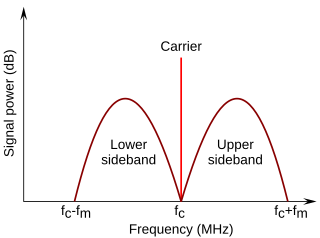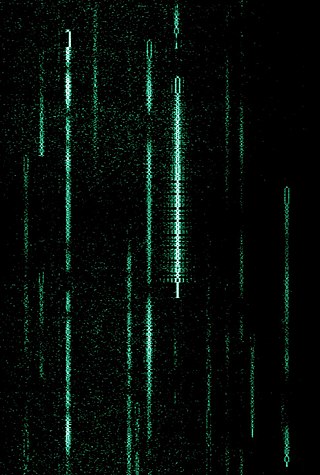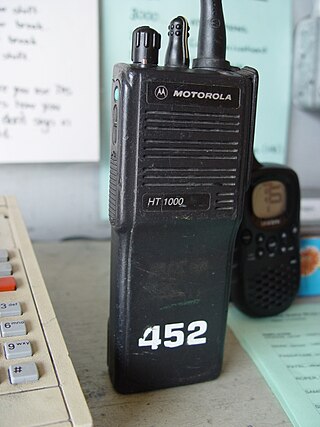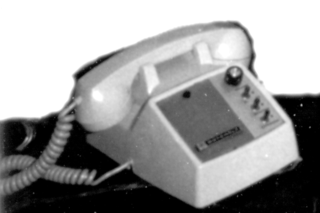Related Research Articles

Dual-tone multi-frequency signaling (DTMF) is a telecommunication signaling system using the voice-frequency band over telephone lines between telephone equipment and other communications devices and switching centers. DTMF was first developed in the Bell System in the United States, and became known under the trademark Touch-Tone for use in push-button telephones supplied to telephone customers, starting in 1963. DTMF is standardized as ITU-T Recommendation Q.23. It is also known in the UK as MF4.

In radio communications, a sideband is a band of frequencies higher than or lower than the carrier frequency, that are the result of the modulation process. The sidebands carry the information transmitted by the radio signal. The sidebands comprise all the spectral components of the modulated signal except the carrier. The signal components above the carrier frequency constitute the upper sideband (USB), and those below the carrier frequency constitute the lower sideband (LSB). All forms of modulation produce sidebands.
In telecommunication, signaling is the use of signals for controlling communications. This may constitute an information exchange concerning the establishment and control of a telecommunication circuit and the management of the network.
In telecommunications, squelch is a circuit function that acts to suppress the audio output of a receiver in the absence of a strong input signal. Essentially, squelch is a specialized type of noise gate designed to suppress weak signals. Squelch is used in two-way radios and VHF/UHF radio scanners to eliminate the sound of noise when the radio is not receiving a desired transmission.

A blue box is an electronic device that produces tones used to generate the in-band signaling tones formerly used within the North American long-distance telephone network to send line status and called number information over voice circuits. During that period, charges associated with long-distance calling were commonplace and could be significant, depending on the time, duration and destination of the call. A blue box device allowed for circumventing these charges by enabling an illicit user, referred to as a "phreaker" to place long-distance calls, without using the network's user facilities, that would be billed to another number or dismissed entirely by the telecom company's billing system as an incomplete call. A number of similar "color boxes" were also created to control other aspects of the phone network.

A radiotelephone, abbreviated RT, is a radio communication system for conducting a conversation; radiotelephony means telephony by radio. It is in contrast to radiotelegraphy, which is radio transmission of telegrams (messages), or television, transmission of moving pictures and sound. The term is related to radio broadcasting, which transmit audio one way to listeners. Radiotelephony refers specifically to two-way radio systems for bidirectional person-to-person voice communication between separated users, such as CB radio or marine radio. In spite of the name, radiotelephony systems are not necessarily connected to or have anything to do with the telephone network, and in some radio services, including GMRS, interconnection is prohibited.

Power-line communication (PLC) is the carrying of data on a conductor that is also used simultaneously for AC electric power transmission or electric power distribution to consumers. The line that does so is known as a power-line carrier.
Multichannel Television Sound (MTS) is the method of encoding three additional audio channels into analog 4.5 MHz audio carriers on System M and System N. It was developed by the Broadcast Television Systems Committee, an industry group, and sometimes known as BTSC as a result.

PSK31 or "Phase Shift Keying, 31 Baud", also BPSK31 and QPSK31, is a popular computer-sound card-generated radioteletype mode, used primarily by amateur radio operators to conduct real-time keyboard-to-keyboard chat, most often using frequencies in the high frequency amateur radio bands (near-shortwave). PSK31 is distinguished from other digital modes in that it is specifically tuned to have a data rate close to typing speed, and has an extremely narrow bandwidth, allowing many conversations in the same bandwidth as a single voice channel. This narrow bandwidth makes better use of the RF energy in a very narrow space thus allowing relatively low-power equipment to communicate globally using the same skywave propagation used by shortwave radio stations.

Audio system measurements are used to quantify audio system performance. These measurements are made for several purposes. Designers take measurements to specify the performance of a piece of equipment. Maintenance engineers make them to ensure equipment is still working to specification, or to ensure that the cumulative defects of an audio path are within limits considered acceptable. Audio system measurements often accommodate psychoacoustic principles to measure the system in a way that relates to human hearing.
In telecommunications, Continuous Tone-Coded Squelch System or CTCSS is one type of in-band signaling that is used to reduce the annoyance of listening to other users on a shared two-way radio communication channel. It is sometimes referred to as tone squelch or PL for Private Line, a trademark of Motorola. It does this by adding a low frequency audio tone to the voice. Where more than one group of users is on the same radio frequency, CTCSS circuitry mutes those users who are using a different CTCSS tone or no CTCSS.
In telecommunications, in-band signaling is the sending of control information within the same band or channel used for data such as voice or video. This is in contrast to out-of-band signaling which is sent over a different channel, or even over a separate network. In-band signals may often be heard by telephony participants, while out-of-band signals are inaccessible to the user. The term is also used more generally, for example of computer data files that include both literal data, and metadata and/or instructions for how to process the literal data.
The Internet Radio Linking Project, also called IRLP links amateur radio stations around the world by using Voice over IP (VoIP). Each gateway consists of a dedicated computer running custom software that is connected to both a radio and the Internet. This arrangement forms what is known as an IRLP Node. Since all end users communicate using a radio as opposed to using a computer directly, IRLP has adopted the motto "Keeping the Radio in Amateur Radio".

Professional mobile radio are person-to-person two-way radio voice communications systems which use portable, mobile, base station, and dispatch console radios. PMR systems are based on such standards as MPT-1327, TETRA, APCO 25, and DMR which are designed for dedicated use by specific organizations, or standards such as NXDN intended for general commercial use. These systems are used by police, fire, ambulance, and emergency services, and by commercial firms such as taxis and delivery services. Most systems are half-duplex, in which multiple radios share a common radio channel, and only one can transmit at a time. Transceivers are normally in receive mode, the user presses a push-to-talk button on his microphone when he wants to talk, which turns on his transmitter and turns off his receiver. They use channels in the VHF and UHF bands, giving them a limited range, usually 3 to 20 miles depending on terrain. Output power is typically limited to 4 watts. Repeaters installed on tall buildings, hills or mountain peaks are used to increase the range of systems.
BORSCHT is an acronym for the set of functions performed by a subscriber line interface circuit (SLIC) in the line card of a telecommunication system providing plain old telephone service. The letters represent the following functions: battery feed (B), overvoltage protection (O), ringing (R), signaling (S), coding (C), hybrid (H), and test (T).

In electronics, noise is an unwanted disturbance in an electrical signal.
In a conventional, analog two-way radio system, a standard radio has noise squelch or carrier squelch, which allows a radio to receive all transmissions. Selective calling is used to address a subset of all two-way radios on a single radio frequency channel. Where more than one user is on the same channel, selective calling can address a subset of all receivers or can direct a call to a single radio. Selective calling features fit into two major categories—individual calling and group calling. Individual calls generally have longer time-constants: it takes more air-time to call an individual radio unit than to call a large group of radios.

Remote controls are used any time a two-way radio base station is located away from the desk or office where communication originates. For example, a dispatch center for taxicabs may have an office downtown but have a base station on a distant mountain top. A Tone remote, also known as an EIA Tone remote, is a signaling system used to operate a two-way radio base station by some form of remote control.
The Yaesu FT-2900R is a VHF 2M FM mobile amateur radio transceiver. It is no longer in production and has been replaced by the FT-2980.
A reed receiver or tuned reed receiver (US) was a form of multi-channel signal decoder used for early radio control systems. It uses a simple electromechanical device or 'resonant reed' to demodulate the signal, in effect a receive-only modem. The encoding used is a simple form of frequency-shift keying.
References
- ↑ Graf, Rudolf F. (1999-08-11). Modern Dictionary of Electronics. Newnes. ISBN 9780080511986.
- ↑ "Analog Multiplex systems: The basics". urgentcomm.com. Retrieved 2017-05-12.
- ↑ Kriegeskorte, Nikolaus; Douglas, Pamela K (April 2019). "Interpreting encoding and decoding models". Current Opinion in Neurobiology. 55: 167–179. doi:10.1016/j.conb.2019.04.002. PMC 6705607 . PMID 31039527.